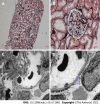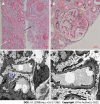Transition from minimal change disease to focal segmental glomerulosclerosis related to occupational exposure: A case report
- PMID: 35979127
- PMCID: PMC9258360
- DOI: 10.12998/wjcc.v10.i17.5861
Transition from minimal change disease to focal segmental glomerulosclerosis related to occupational exposure: A case report
Abstract
Background: Although minimal change disease (MCD) and focal segmental glomerulosclerosis (FSGS) have been described as two separate forms of nephrotic syndrome (NS), they are not completely independent. We report a case of a patient transitioning from MCD to FSGS, review the literature, and explore the relationship between the two diseases.
Case summary: A 42-year-old male welder, presenting with lower extremity edema and elevated serum creatinine, was diagnosed with NS and end-stage kidney disease (ESKD) based on laboratory test results. The patient had undergone a kidney biopsy for NS 20 years previously, which indicated MCD, and a second recent kidney biopsy suggested FSGS. The patient was an electric welder with excessive levels of cadmium and lead in his blood. Consequently, we suspect that his aggravated pathology and occurrence of ESKD were related to metal nephrotoxicity. The patient eventually received kidney replacement therapy and quit his job which involved long-term exposure to metals. During the 1-year follow-up period, the patient was negative for metal elements in the blood and urine and recovered partial kidney function.
Conclusion: MCD and FSGS may be different stages of the same disease. The transition from MCD to FSGS in this case indicates disease progression, which may be related to excessive metal contaminants caused by the patient's occupation.
Keywords: Cadmium; Case report; Focal segmental glomerulosclerosis; Lead; Minimal change disease; Occupational exposure.
©The Author(s) 2022. Published by Baishideng Publishing Group Inc. All rights reserved.
Conflict of interest statement
Conflict-of-interest statement: The authors declare that they have no conflict of interest.
Figures


Similar articles
-
Pemphigus vulgaris and focal segmental glomerulosclerosis (FSGS): First reported case and a review of the literature.Clin Case Rep. 2023 Jul 18;11(7):e7716. doi: 10.1002/ccr3.7716. eCollection 2023 Jul. Clin Case Rep. 2023. PMID: 37476592 Free PMC article.
-
Comparative differential proteomic analysis of minimal change disease and focal segmental glomerulosclerosis.BMC Nephrol. 2017 Feb 3;18(1):49. doi: 10.1186/s12882-017-0452-6. BMC Nephrol. 2017. PMID: 28158993 Free PMC article.
-
Morphological Features of Minimal Change Disease and Focal Segmental Glomerulosclerosis Using Repeat Biopsy and Parietal Epithelial Cell Marker.Kidney Dis (Basel). 2020 Mar;6(2):119-124. doi: 10.1159/000505125. Epub 2020 Jan 31. Kidney Dis (Basel). 2020. PMID: 32309294 Free PMC article.
-
Rituximab therapy for focal segmental glomerulosclerosis and minimal change disease in adults: a systematic review and meta-analysis.BMC Nephrol. 2020 Apr 15;21(1):134. doi: 10.1186/s12882-020-01797-7. BMC Nephrol. 2020. PMID: 32293308 Free PMC article.
-
Emerging therapeutic strategies for minimal change disease and focal and segmental glomerulosclerosis.Expert Opin Investig Drugs. 2018 Nov;27(11):839-879. doi: 10.1080/13543784.2018.1540587. Epub 2018 Oct 30. Expert Opin Investig Drugs. 2018. PMID: 30360670 Review.
Cited by
-
Nephrotic Syndrome Associated With Heavy Metals Exposure: A Case Report and Literature Review.Cureus. 2024 Jan 10;16(1):e52029. doi: 10.7759/cureus.52029. eCollection 2024 Jan. Cureus. 2024. PMID: 38344529 Free PMC article.
-
Current understanding of the molecular mechanisms of circulating permeability factor in focal segmental glomerulosclerosis.Front Immunol. 2023 Sep 19;14:1247606. doi: 10.3389/fimmu.2023.1247606. eCollection 2023. Front Immunol. 2023. PMID: 37795085 Free PMC article. Review.
-
Development and validation of a simple-to-use nomogram for predicting minimal change disease based on quantification of color Doppler sonography data from a region of interest.Abdom Radiol (NY). 2023 Mar;48(3):1020-1032. doi: 10.1007/s00261-022-03780-2. Epub 2023 Jan 10. Abdom Radiol (NY). 2023. PMID: 36627405
References
Publication types
LinkOut - more resources
Full Text Sources
Miscellaneous

